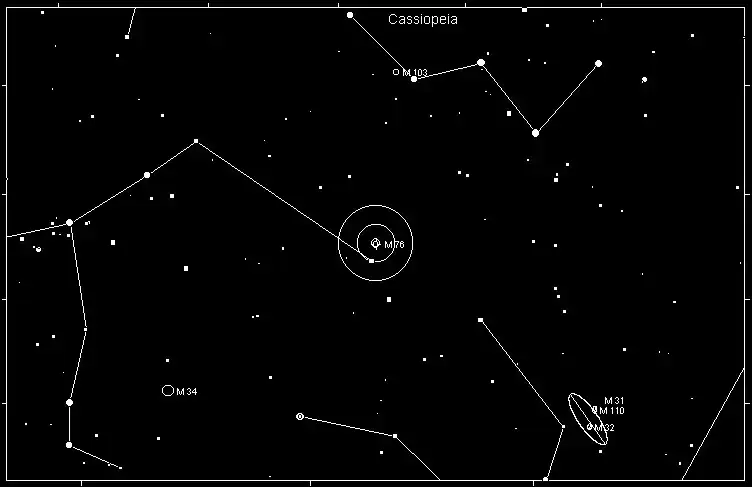Messier 76 (M76), also known as the Little Dumbbell Nebula, is one of the more enigmatic objects cataloged by Charles Messier. This planetary nebula, located in the constellation Perseus, has fascinated astronomers with its structure and relative faintness compared to other nebulae. It is named the Little Dumbbell Nebula due to its visual similarity to the more famous Dumbbell Nebula (M27), though it is significantly smaller and fainter.
Messier 76 is a planetary nebula, the glowing remnants of a star that has shed its outer layers. At its center lies a white dwarf, a hot but small and dense star that emits ultraviolet light, which causes the surrounding gas to glow. The nebula is composed of two lobes, giving it a bipolar structure, which is a common characteristic among planetary nebulae. The Little Dumbbell Nebula spans about 1.5 light-years and is estimated to be around 2,500 light-years away from Earth.
The nebula is visually complex, with a central region that appears bright and elongated, surrounded by fainter, diffuse material. This structure gives it an uneven appearance, and different parts of the nebula emit light at various wavelengths, making it a challenging yet rewarding target for both amateur and professional astronomers.
Magnitude
Messier 76 has an apparent magnitude of approximately 10.1, making it one of the fainter objects in the Messier catalog. Its faintness can make it difficult to observe through small telescopes, and dark skies away from city lights are recommended to see it clearly. The nebula's relatively small size, combined with its dimness, makes it a more challenging target compared to brighter and larger nebulae.
Seasonal Visibility
M76 is best observed in the late fall and early winter months in the Northern Hemisphere, particularly from October to December. During this period, the constellation Perseus, where the nebula resides, is high in the night sky, making it easier to locate and observe.
Constellation
Messier 76 is located in the constellation Perseus, which is home to many other interesting deep-sky objects. Perseus is a prominent constellation in the Northern Hemisphere's winter sky and is associated with the Greek hero Perseus from mythology. The constellation is well-known for containing the famous variable star Algol, the Perseus Cluster of galaxies, and other notable objects like the Double Cluster.
To locate M76, begin by finding the constellation Perseus, which is best identified by its bright stars, including Mirfak (Alpha Persei) and Algol (Beta Persei). Once Perseus is identified, you can use the stars of the constellation Andromeda, which is nearby, as additional reference points.
Start by locating the bright star Beta Andromedae (Mirach) in the Andromeda constellation. From Mirach, move towards the northeast until you reach the star Phi Persei, located in Perseus. M76 is situated just about 3 degrees northwest of Phi Persei.
The nebula can be a challenge to spot visually because of its faintness, so using a detailed star chart or a smartphone app to help with star-hopping can be beneficial. Even though it has a low magnitude, once you've found the general location, increasing the magnification on your telescope and using an OIII filter can help bring out more detail of the nebula's structure.

Messier 76 was discovered by French astronomer Pierre Méchain in 1780, shortly before being included in Charles Messier's catalog of deep-sky objects. Originally, the nebula was thought to be two separate objects because of its bipolar appearance, and it was even assigned multiple New General Catalogue (NGC) numbers: NGC 650 and NGC 651. However, it was later determined that these two numbers referred to the same object.
Like other planetary nebulae, M76 represents the final stages in the life of a medium-sized star, which sheds its outer layers as it runs out of nuclear fuel. The central star then contracts into a white dwarf, illuminating the surrounding gas. Despite being one of the fainter Messier objects, M76 has been studied extensively in modern astronomy to understand the evolution of planetary nebulae and the processes that lead to their formation.
Messier 76, the Little Dumbbell Nebula, offers an intriguing challenge for astronomers with its faint magnitude and unique structure. Nestled in the constellation Perseus, it is best viewed during the fall and early winter months. While its faintness requires careful observation, those who find and study this nebula will be rewarded with a deeper appreciation of the life cycle of stars and the beauty of the night sky.
